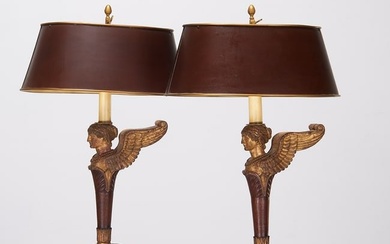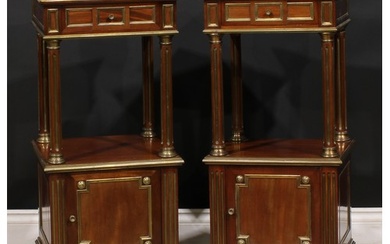A Pair of Empire Parcel-Gilt and Painted Wood Figures of Antinous as the God Osiris with Feather Headdress, Early 19th Century
A Pair of Empire Parcel-Gilt and Painted Wood Figures of Antinous as the God Osiris with Feather Headdress,
Early 19th Century
overall height including walnut base 44 ¼ in.
112.5 cm
Catalogue Note:
The young favorite of the Emperor Hadrian, Antinous drowned in the Nile during an Imperial visit to Egypt in 130 AD, and the heartbroken Emperor had Antinous deified and ordered shrines to be built throughout the Empire. Due to the nature of his death, Antinous was often depicted as the Egyptian god Osiris wearing Nemes (In this case these figures wear feather head dresses) the most famous surviving example of this iconography is an over life-size statue unearthed at Hadrian's Villa in Tivoli in 1740 and displayed from 1742 in the Capitoline and from 1838 in the Vatican Museum.
The Antinous statue quickly captured the public imagination and was reproduced by both Piranesi and Hubert Robert among others, contributing to the burgeoning interest in Egyptian taste as part of the broader neoclassical revival of the later 18th century. Cardinal Albani incorporated a pair of copies of the Vatican statue in his Roman villa constructed between 1747 and 1767, and versions were recorded in the gardens of the Villa Borghese and the Palazzo Barberini.
North of the Alps, a virtually identical pair of figures flank the door of the Blue Hall at the Palace of Ostankino near Moscow (Turchin, 1979, pl.99). The palace was built between 1792 and 1798 by Count Sheremetev and his wife Princess Cherkasskaya. The majority of interior decoration was executed by Russian architect P. Argunov. In England the collector and connoisseur Thomas Hope had a version in his London house-museum in Duchess Street.
In France, the sculptor Pierre-Nicolas Beauvallet (1750-1818) produced a copy after the Vatican statue for the neo-Egyptian Fontaine du Fellah in the Rue de Sèvres in Paris, built in 1806, and a pair of bleu turquin marble Antinous figures attributed to Beauvallet and comparable to the offered lot are now in the Musee Marmottan, Paris.
Provenance:
Decorative Arts from the Collection of Carter Burden, Sotheby's New York, 18 October 2003, Lot 109
View it on
Sale price
Estimate
Reserve
Time, Location
Auction House
A Pair of Empire Parcel-Gilt and Painted Wood Figures of Antinous as the God Osiris with Feather Headdress,
Early 19th Century
overall height including walnut base 44 ¼ in.
112.5 cm
Catalogue Note:
The young favorite of the Emperor Hadrian, Antinous drowned in the Nile during an Imperial visit to Egypt in 130 AD, and the heartbroken Emperor had Antinous deified and ordered shrines to be built throughout the Empire. Due to the nature of his death, Antinous was often depicted as the Egyptian god Osiris wearing Nemes (In this case these figures wear feather head dresses) the most famous surviving example of this iconography is an over life-size statue unearthed at Hadrian's Villa in Tivoli in 1740 and displayed from 1742 in the Capitoline and from 1838 in the Vatican Museum.
The Antinous statue quickly captured the public imagination and was reproduced by both Piranesi and Hubert Robert among others, contributing to the burgeoning interest in Egyptian taste as part of the broader neoclassical revival of the later 18th century. Cardinal Albani incorporated a pair of copies of the Vatican statue in his Roman villa constructed between 1747 and 1767, and versions were recorded in the gardens of the Villa Borghese and the Palazzo Barberini.
North of the Alps, a virtually identical pair of figures flank the door of the Blue Hall at the Palace of Ostankino near Moscow (Turchin, 1979, pl.99). The palace was built between 1792 and 1798 by Count Sheremetev and his wife Princess Cherkasskaya. The majority of interior decoration was executed by Russian architect P. Argunov. In England the collector and connoisseur Thomas Hope had a version in his London house-museum in Duchess Street.
In France, the sculptor Pierre-Nicolas Beauvallet (1750-1818) produced a copy after the Vatican statue for the neo-Egyptian Fontaine du Fellah in the Rue de Sèvres in Paris, built in 1806, and a pair of bleu turquin marble Antinous figures attributed to Beauvallet and comparable to the offered lot are now in the Musee Marmottan, Paris.
Provenance:
Decorative Arts from the Collection of Carter Burden, Sotheby's New York, 18 October 2003, Lot 109





